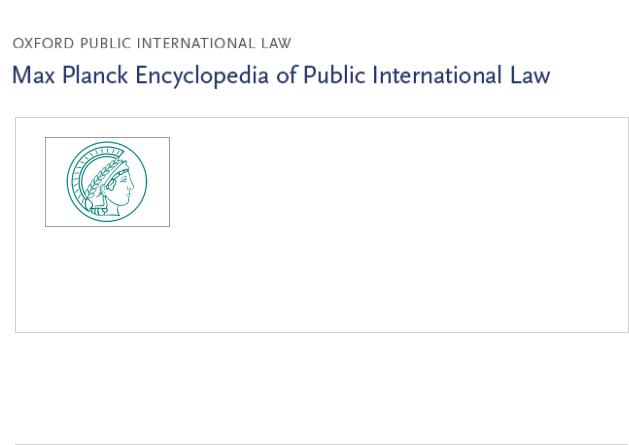
EPIL_Oil_Platforms_Case_Iran_v_United_States_of_America
.pdf
Oil Platforms Case (Iran v United
States of America)
Michael Bothe
Content type: |
Product: Max Planck |
Encyclopedia Entries |
Encyclopedia of Public |
Article last updated: April |
International Law [MPEPIL] |
2011 |
|
Subject(s):
Armed attack — Armed forces — Armed conflict — Self-defence
Published under the auspices of the Max Planck Foundation for International Peace and the Rule of Law under the direction of Rüdiger Wolfrum.
From :Oxford Public InternationalLaw (htp://opil.ouplaw.com ).(c)Oxford U niversity Press,2013.AllRightsReserved.Subscriber: null;date:17 Decem ber2014

A. The Facts of the Case
1 Iran brought an action against the United States of America concerning two attacks by US armed forces destroying a number of Iranian oil production installations in the Persian Gulf which occurred during the armed conflict between Iraq and Iran (1980–88). They were incidents of the so-called ‘Tanker War’ in which acts of force took place against ships transporting oil from both Iran and Iraq, while the exact circumstances of such uses of force have remained a matter of controversy. As a result of this situation, a number of States, in particular the United States, sent warships to the Persian Gulf in order to protect their interest in secure oil supplies.
2 The two attacks as such are not in dispute. The first one took place on 19 October 1987. It completely destroyed one Iranian oil platform and severely damaged another. Production from the platforms was interrupted for several years. The second attack took place on 18 April 1988. It completely destroyed two Iranian offshore oil production complexes. Production was interrupted for four years. The attacks were part of a larger military operation against Iranian naval forces which resulted, inter alia, in the destruction of two Iranian frigates and a number of other Iranian ships.
3 In both cases, the United States argued to have acted in self-defence. Claims that the armed attacks triggered this right of self-defence are controversial. In the first case, a missile had hit the Sea Isle City—a ship flying the US flag—in Kuwait harbour. It caused some damage to the ship and injured six crew members. The US claimed that the missile was launched by Iran, which Iran denied.
4 Four days before the second attack, the US warship Samuel B Roberts struck a mine in international waters near Bahrain. The ship was severely damaged but not sunk; there were no casualties among the crew. The US claimed that the mine was laid by Iran, which Iran denied.
5 In addition to these two alleged Iranian attacks, the United States claimed that there was a general situation of Iranian hostility vis-à-vis the US which had also triggered a right of self-defence.
B. The Proceedings
6 On 2 November 1992, Iran filed an application with the ICJ requesting the Court to declare that the attacks constituted a breach of various provisions of the Treaty of Amity, Economic Relations, and Consular Rights between the United States of America and Iran of 15 August 1955 (‘Treaty of Amity’). By its judgment of 12 December 1996, the Court rejected the preliminary objections of the United States claiming that this treaty did not provide a basis for the Court’s jurisdiction.
7 The United States then filed a counter-claim for damages arising out of a number of alleged Iranian attacks against ships which flew the United States’ flag or were alleged to be US owned.
8 On 6 November 2003, the Court delivered its judgment on the merits, in the result rejecting both the claim (by 14 votes to 2) and the counterclaims (by 15 votes to 1).
C. The Jurisdiction of the Court
9 The Treaty of Amity between the US and Iran belongs to a series of treaties concluded by the US which had essentially the same content. A similar treaty had been concluded between the US and Nicaragua and had been one of the bases of the jurisdiction of the ICJ in the Military and Paramilitary Activities in and against Nicaragua Case (Nicaragua v United States of America) decided in 1986. Both treaties contain a dispute settlement clause relating to the ‘interpretation of application’ of the treaty allowing the unilateral submission to the ICJ. In its judgment on the preliminary objections, the Court held that it had jurisdiction concerning Art. X (1) of the Treaty: ‘Between the territories of the two High Contracting Parties there shall be freedom of commerce and navigation’.
From :Oxford Public InternationalLaw (htp://opil.ouplaw.com ).(c)Oxford U niversity Press,2013.AllRightsReserved.Subscriber: null;date:17 Decem ber2014

10 In contradistinction to the Nicaragua Case, the treaty was the only basis of the jurisdiction in the Iranian case. This seriously limited the scope of the legal assessment by the Court. The Iranian claim and the US counterclaims could only succeed if and to the extent that the attacks constituted violations of the said treaty provision because they prevented ‘commerce and navigation’ between Iran and the US. Whether or not the attacks in question constituted a violation of the United Nations Charter or of customary international law concerning the use of military force could thus only be addressed as a question incidental to that of the violation of the treaty. This limitation determined the structure of the legal argument of the parties and, finally, of the Court.
D. The Merits
11In the overall structure of the legal argument, the question of the prohibition of the use of force is relevant in two different contexts: on the one hand, the question is whether, if the attacks constituted a violation of the treaty, they were justified as an exercise of the right of self-defence and thus precluded the wrongfulness of those attacks (Art. 21 ILC Articles on State Responsibility). On the other hand, the question of the prohibition of the use of force becomes relevant in the application of Art. XX (1) (d) Treaty of Amity: ‘The present Treaty shall not preclude the application of measures … (d) … necessary to protect its essential security interests’.
12In contradistinction to the order of the legal argument adopted in the Nicaragua Case, the Court started with the second element, ie with the question; whether the application of the Treaty was excluded by the fact that essential security interests of a party were at stake? As in the Nicaragua Case, the Court held that the clause could not be meant to shield unlawful uses of force. In order to be excluded from the prohibitions of the treaty, a use of force had thus to be in conformity with the international legal rules governing the use of force. This line of argument enabled the Court to start its reasoning on the substantive issues of the case by addressing the issue of whether the US attacks were justified as an exercise of the right of self-defence.
13The right of self-defence presupposes an armed attack against the State exercising that right by the State against which measures of self-defence are directed. The State relying on the right of self-defence bears the burden of proof for all facts which must be present in order to trigger that right, in particular the existence of a prior armed attack. In the case of a non liquet, the plea of selfdefence fails. In the first case—that of the missile attack against the ship in Kuwait harbour—the Court concluded that the US had not discharged its burden of proof in relation to two relevant facts: first, there was not sufficient evidence that the missile attack came from Iran; secondly, it could not be shown that this and a number of further attacks the US claimed to be victim of, even assuming Iran was responsible for them, were actually directed at the US.
14In the second case, the essential question of fact was whether the mine which struck the US warship was laid by Iran. In this case, too, the Court was of the view that the evidence put forward was ‘not conclusive’.
15The Court also examined the supplementary contention of the US that acts of hostility allegedly perpetrated by Iran taken together had triggered a US right of self-defence. Even if they could be attributed to Iran, they would not, taken cumulatively, be acts of sufficient gravity as to amount, according to the standard developed in the Nicaragua Case, to an armed attack.
16Although the US had not proven the existence of an armed attack, the Court also analysed the requirements of necessity and proportionality as being a prerequisite of a lawful exercise of selfdefence and being also relevant pursuant to Art. XX (1) (d) Treaty of Amity. As it could not be proven that the platforms were of military significance, the attacks on them could not be considered a ‘necessary’ response. As to proportionality, the second attack, which not only caused considerable damage to the platforms but was part of a larger operation destroying a number of Iranian warships, was clearly disproportionate in relation to the limited damage which
From :Oxford Public InternationalLaw (htp://opil.ouplaw.com ).(c)Oxford U niversity Press,2013.AllRightsReserved.Subscriber: null;date:17 Decem ber2014

had been caused to the US warship. On the basis of this reasoning, the Court concluded that the application of the Treaty of Amity was not excluded by virtue of Art. XX (1) (d) and thus examined whether the US attacks violated its Art. X. The scope of protection of that provision is limited to commerce and navigation ‘between the territories of the High Contracting Parties’, not commerce in general. According to Executive Order No. 12613 (‘Prohibiting Imports from Iran’) issued by the US President in October 1987, no Iranian crude oil produced by the platforms could have been sold to the United States any more. Thus, there was no commerce between the territories of the Parties which would have been protected by Art. X. Nor was indirect trade via third parties protected. Thus, there was no violation of the treaty.
17 For the same reason, the attacks which were the object of the counter-claims, whoever was responsible for them or damaged by them, could not constitute violations of the Treaty of Amity. None of the ships allegedly attacked by Iran was engaged in commerce between Iran and the US.
E. The Significance and Impact of the Judgment
18A major critique voiced in legal doctrine against the judgment concerns the order of the reasoning. In order to come to the final result of rejecting Iran’s claim, it was indeed not strictly necessary to deal with the questions relating to the use of force. Had the Court examined the issues involved in the order it had adopted in the Nicaragua Case, it would have stated that there was no violation of Art. X Treaty of Amity and the question of self-defence did not have to be dealt with. The Court, however, did not limit its reasoning in this way. It used the opportunity to restate its views on the law relating to the use of force and self-defence, and thus to contribute to the development of international law. As a result of this approach, the Court implicitly held that Iran had a claim against the US, but none on which the Court had jurisdiction in the present proceedings. This approach has been criticized, arguing that the Court went beyond its proper task of deciding cases giving reasons beyond what was strictly necessary to explain the result of denying the claim. The Court, aware of this problem, held that the order in which issues were addressed was a matter of the Court’s free choice. In the present case, it was of the view that in the light of the impact of the general rules of international law on the interpretation and of Art. XX Treaty of Amity, those general rules had to be addressed first. In adopting this approach, the Court fulfilled an important function it has beyond that of deciding specific cases. It has a role to play in the clarification and development of international law, it takes part in the international discourse which continuously determines the scope and meaning of that law. Judge Simma, in his separate opinion, expressly evokes that responsibility of the Court.
19It has thus to be asked what is the contribution of this particular judgment to the said international legal discourse. The most important clarification probably is that the Court continues to base its legal opinions relating to the use of force on the Nicaragua judgment. However, the Court did not go beyond what was already stated in that case. Thus, it avoided any reasoning which could have been understood as addressing certain questions of self-defence discussed after the events of 11 September 2001, eg the use of force by non-State actors and the duration of an armed attack although some of these issues were touched upon in the pleadings. These issues have only been addressed by the Court in later cases (see Israeli Wall Advisory Opinion (Legal Consequences of the Construction of a Wall in the Occupied Palestinian Territory; Armed Activities on the Territory of the Congo Cases).
20The second important clarification is that the State relying on self-defence bears the burden of proof concerning all facts which are the basis of such claim, in particular the existence of an armed attack directed against that particular State (unless there is a case of collective self-defence). The Court, however, has not clarified the standard of proof, ie rules which determine whether evidence has to be regarded as conclusive or not.
21Third, the Court clarified that the right of self-defence is limited by the principles of necessity
From :Oxford Public InternationalLaw (htp://opil.ouplaw.com ).(c)Oxford U niversity Press,2013.AllRightsReserved.Subscriber: null;date:17 Decem ber2014

and proportionality.
Select Bibliography
P D’Argent ‘Du commerce à l’emploi de la force: L’affaire des plates-formes pétrolières (arrêt sur le fonds),’ (2003) 49 AFDI 266–89.
CE Foster ‘The Oil Platforms case and the use of force in international law’ (2003) 7 Singapore Journal of International and Comparative Law 579–88.
C Barthe-Gay ‘Le jeu de l’unilatéral, du bilatéral et du multilatéral en droit international: Observations sous l’arrêt de la Cour international de justice du 6 novembre 2003 dans l’affaire des Plates-formes pétrolières (Iran c. Etats-Unis)’ (2004) 37 RBDI 71–91.
A Garwood-Gowers ‘Case concerning oil platforms (Islamic Republic of Iran v. United States of America): Did the ICJ miss the boat on the law on the use of force?’ (2004) 5 Melbourne Journal of International Law 241–55.
A Gattini ‘La legittima difesa nel nuove secolo: la sentenza della Corte internazionale di giustizia nell’affare delle plattaforme petrolifere’ (2004) 87 Rivista di diritto internazionale 147–70.
J Kammerhofer ‘ Oil ’s well that ends well?, Critical Comments on the merits judgment in the Oil Platforms case’ (2004) 17 LJIL 695–718.
A Laursen ‘The judgment by the International Court of Justice in the Oil Platforms case’ (2004) 73 NordicJIL 135–60.
D Momtaz ‘Did the Court miss an opportunity to denounce the erosion of the principle prohibiting the use of force?’ (2004) 29 YaleJIntlL 307–13.
D Raab ‘“Armed Attack” after the Oil Platforms case’ (2004) 17 LJIL 719–35.
DA Small ‘The Oil Platforms case: jurisdiction through the–closed–eye of the needle’ (2004) 3 LPICT 113–24.
W Taft ‘Self-defence and the Oil Platforms decision’ (2004) 29 YaleJIntlL 295–306.
E Tourmé-Jouannet ‘Le juge international face aux problèmes d’incohérence et d’instabilité du droit international: Quelquses réflexions à propos de l’arrêt de CIJ du 6 novembre 2003, Affaire des Plates-formes pétrolières’ (2004) 108 RGDIP 917–48.
L von Carlowitz ‘The Oil Platforms case before the International Court of Justice: a contribution to the present debate on self-defence?’ (2005) 15 Schweizerische Zeitschrift für Internationales und Europäisches Recht 255–80.
V Heiskanen ‘ Oil Platforms : lessons of dissensus’ (2005) 74 NordicJIL 179–208.
K Oellers-Frahm ‘The International Court of Justice and Article 51 of the UN Charter’ in K Dicke and others (eds) Weltinnenrecht. Liber amicorum Jost Delbrück (Duncker & Humblot Berlin 2005) 503–17.
M Jacobsson ‘Evidence as an Issue in International Legal Practice’ (2006) 100 ASIL Proceedings 40–44.
ME O’Connell, ‘Rules of Evidence for the Use of Force in International Law’s New Era’ (2006) 100 ASIL Proceedings 44–47.
Select Documents
Oil Platforms (Islamic Republic of Iran v United States of America) (Judgment) [2003] ICJ Rep 161.
Oil Platforms (Islamic Republic of Iran v United States of America) (Preliminary Objection, Judgment) [1996] ICJ Rep 803.
Treaty of Amity, Economic Relations, and Consular Rights between the United States of America and Iran (signed 15 August 1955, entered into force 16 June 1957) 284 UNTS 93.
From :Oxford Public InternationalLaw (htp://opil.ouplaw.com ).(c)Oxford U niversity Press,2013.AllRightsReserved.Subscriber: null;date:17 Decem ber2014
From :Oxford Public InternationalLaw (htp://opil.ouplaw.com ).(c)Oxford U niversity Press,2013.AllRightsReserved.Subscriber: null;date:17 Decem ber2014
